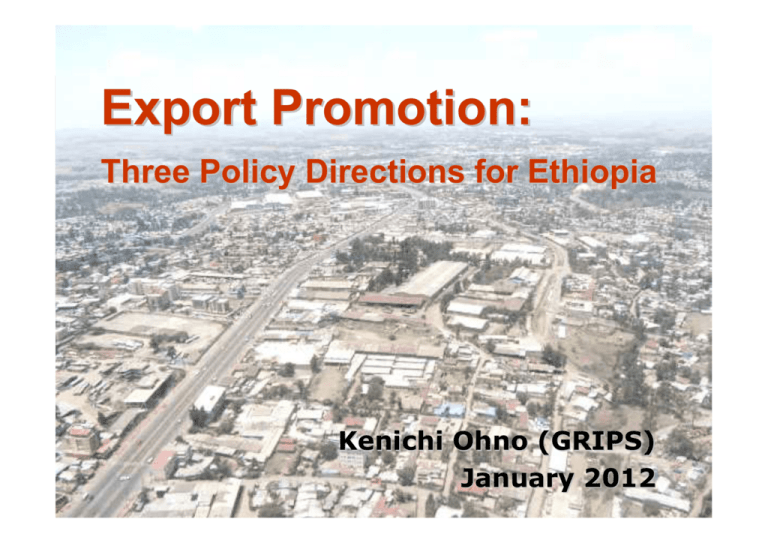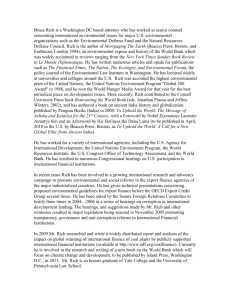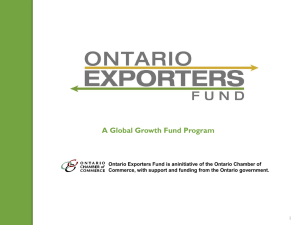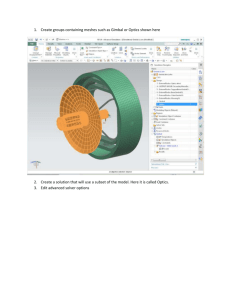Export Promotion Policy: Three Policy Directions for Ethiopia
advertisement

Export Promotion: Three Policy Directions for Ethiopia Kenichi Ohno (GRIPS) January 2012 Export Promotion under PASDEP 2005/06-2009/10 Export drive was top priority for national development. The monthly export steering committee was set up and used fairly effectively for policy monitoring. A few export-oriented sectors were targeted for policy attention, incentives and ODA support. Sector-specific institutes were created and master plans were drafted. However, industry’s export performance was less than expected and its GDP share did not expand greatly (stagnant around 13%). Suggested Policy Directions Based on past policy experience, the scope of export promotion should be expanded. 1. 2. 3. Integrated policy—export promotion should be an integral part of an overall industrialization strategy. Demand orientation—policy must be designed to meet specific needs of buyers, not just for general improvements on supply-side. Re-formulating export policy—modality of incentives must be improved, and policy menu should be expanded. Government should offer customer-oriented policy services. (1) Integrated Policy Export promotion should not be the final goal, but one of the key policy tools for achieving broad-based industrial development. Export policy should be linked closely with other policy tools. All policy tools, including export promotion, should be strengthened greatly for producing results. GTP: Targeted industrial growth: 20.0% (base), 21.3% (high) per year “Building an industrial sector that plays a leading role in the economy” MSEs: MLEs: jobs & urbanrural linkage eight targeted sectors Industrial zone development Public enterprise policy Existing and forthcoming policy tools in Ethiopia TVET MSE promotion Export promotion Kaizen Mutual linkage and consistency must be ensured Industrial clusters Strategic FDI & ODA Engineering universities Technology transfer GTP: Industrial policy organization? Monthly, chaired by PM Meles; policy monitoring and trouble-shooting National Export Steering Committee Customs & logistics Finance coordination Infrastructure Supply & marketing Revenue & Customs Authority National Bank Min. of Industry Min. of Agriculture Subcommittees for interministerial coordination Officially connected (reporting)? Role differentiation? Ethiopian Economic & Business Diplomacy National Coordination Committee (NCC) Infrastructure & technology transfer Foreign trade Facilitation & promotion FDI recruitment & facilitation Min. of Transport Min. of Trade Min. of Industry Monthly, since 2011; chaired by DPM Hailemariam Dessalegn; For trade expansion, FDI attraction, tech. transfer? Tourism recruitment & facilitation Min. of Culture & Tourism Subcommittees for interministerial coordination Malaysia: Institutional Structure Ministry of Int’l Trade and Industry MITI’s key departments Strategic Planning Entrepreneurship Development Sectoral Policy & Industrial Service Implementing agencies under MITI -SME Corp. Malaysia (SMEs) -Malaysian Ind. Dev. Authority (FDI) -Malaysia Productivity Corp. (research, training, consultation) -SME Bank (finance) -Malaysian Ind. Dev. Finance (finance) -MATRADE (trade) Investment Policy & Trade Facilitation Private sector partners Services Sector Development Service & training providers (private consultants & companies) Malaysia: Policy Structure Third Industrial Master Plan (IMP3), 2006-2020 25 chapters, 247 pages 2 preliminary chapters 1. Performance & challenges 2. Macro-framework 8 issue chapters 3. External trade 4. Investments 5. SME development 6. Branding 22. Enhancing domestic capabilities 23. Human resource 24. ICT & other technology developments 25. Logistics 15 sectoral chapters 7. Growth areas in manufacturing 20. Growth areas in services 8. Electrical & Electronics 9. Medical devices 10. Textiles & apparel 11. Machinery & equipment 12. Metals 13. Transport equipment 14. Petrochemicals 15. Pharmaceuticals 16. Wood 17. Rubber products 18. Oil palm 19. Food processing 21. Halal industry (2) Demand Orientation Kaizen, TVET, local procurement, and engineering universities are supply-side measures (enhancing human & enterprise capacities). More attention should be given to buyers and users; capacity building should be finetuned to meet their needs. By listening to and fulfilling their tough and concrete requirements, industrial capability should be strengthened and foreign markets should be secured. Producing what customers want, not selling what you have produced. Customer Orientation as the Most Basic Business Principle In a market economy, demand dictates supply—unlike a planned economy where supply shortage is common and consumers cannot choose or complain about quality. Government should not be a regulator but a service provider for exporters: Providing market and industry information One-stop service for export facilitation Introducing global standards and technology Business matching between buyers and sellers Responding to private sector requests, etc. Toyota: “Delivering what customers want, when they want it, in quantities they want.” Risk of Overproducing Unwanted Skills and Products Even if human and enterprise capacities improve generally, they may not find jobs or markets due to (i) small demand; or (ii) mismatch between wanted and offered skills or products. This may cause business slump, brain drain or social discontent. Given limited time and resources, it is better to target skill and technology improvements to specific areas demanded by customers rather than general improvements. (3) Re-formulating Export Policy Modality of incentives must be improved for effectiveness, transparency and fairness, and future WTO compatibility. Incentives should not be the only or main tool for export promotion; many other tools should be added. Direct export subsidies are prohibited under WTO. But support for human & enterprise capabilities, which indirectly strengthen export, are not only accepted but widely practiced. Lessons from Korean Experience, 1960s-1970s Export targets were set for products and markets only; individual export firms were not given targets and thus were not monitored or penalized for missing them. Incentives were given for past export performance, not for future promise. No firm could receive them without actually exporting. Financial incentives were only a small part of Korea’s export policy. They cannot be evaluated independently from the overall policy package. Sources: correspondence with Dr. Wonhyuk Lim, Dr. Yeon Seung Chung, and HE Mr. Lee Sun-jin in response to the question raised by HE Mr. Mekonnen Manyazewal. Korea’s Export Policy Package, 1960s-1970s Korea Trade Promotion Corporation (KOTRA) Monthly export promotion meetings Medals and national recognition for excellent performers Export credit system and export insurance Export Information Center Export Promotion Special Account Fund to subsidize trade fair participation, etc. Export Idea Bank Automatic import rights for exporters Network of exporters’ associations (Cont.) Creation of general trading houses Incentives and subsidies (many of these are now prohibited under WTO) Promotion laws for heavy-chemical industries (1970s only) Note: In the 1960s, Korea’s export promotion emphasized general export growth without specifying sectors or products. In the 1970s, capital-intensive industries were targeted and strongly promoted. Sources: Wontack Hong (1977); Wonhyuk Lim (2010). Subsidies That Indirectly Enhance Export Performance Below are practiced widely around the world even today without violating WTO/FTAs/EPAs: Subsidies for worker training Subsidies for improving management, technology, R&D, product development Privileged financial access for SMEs Trade-related information, surveys, seminars, enterprise consultation Support for marketing, branding, IT, insurance, joining trade fairs and missions Cheap rents and one-stop services in industrial estates Start-up and incubation support How to Expand Export Policy Menu Ethiopia should expand export policy menu step by step, based on sufficient studies. Re-formulate export incentives for cost effectiveness, selection criteria, effective monitoring, future WTO conformity… After comparing policies practiced abroad, selectively learn and introduce new export policy tools. After studying various foreign models, create an agency that specializes export promotion. Strengthen its capacity over time with more study and international cooperation.





